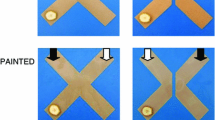Abstract
Problem solving often relies on generating new responses while inhibiting others, particularly prepotent ones. A paradigm to study inhibitory abilities is the reverse contingency task (Boysen and Berntson in J Exp Psychol Anim Behav Process 21:82–86, 1995), in which two different quantities of food are offered to an individual who receives the array he did not choose. Therefore, mastery of the task demands selecting the smaller quantity to obtain the larger one. Several non-human primates have been tested in the reverse contingency task. To date, only great apes and rhesus monkeys (Macaca mulatta) have succeeded in the original task, with no need of procedural modifications as the large-or-none contingency, correction trials or symbolic stimuli substituting for actual food quantities. Here, four mangabeys were presented with two stimulus arrays of one and four raisins in the context of the reverse contingency task. Three of them learned to perform the task well above chance without a modified procedure. They also reached above-chance performance when presented with two stimulus arrays of zero and four raisins, despite the initial difficulty of choosing a null quantity. After a period of 7–10 months, in which the animals were not tested on any task, all three subjects continued to perform well, even when presented with novel quantity pairs.


Similar content being viewed by others
References
Anderson JR, Awazu S, Fujita K (2000) Can squirrel monkeys (Saimiri sciureus) learn self-control? A study using food array selection tests and reversed reward contingency. J Exp Psychol Anim Behav Process 26:87–97
Anderson JR, Awazu S, Fujita K (2004) Squirrel monkeys (Saimiri sciureus) choose smaller food arrays: long-term retention, choice with nonpreferred food, and transposition. J Comp Psychol 118:58–64
Boysen ST, Berntson GG (1995) Responses to quantity: perceptual versus cognitive mechanisms in chimpanzees (Pan troglodytes). J Exp Psychol Anim Behav Process 21:82–86
Boysen ST, Berntson GG, Hannan MB, Cacioppo JT (1996) Quantity-based interference and symbolic representations in chimpanzees (Pan troglodytes). J Exp Psychol Anim Behav Process 22:76–86
Boysen ST, Mukobi KL, Berntson GG (1999) Overcoming response bias using symbolic representations of number by chimpanzees (Pan troglodytes). Anim Learn Behav 27:229–235
Boysen ST, Berntson GG, Mukobi KL (2001) Size matters: impact of size and quantity on array choice by chimpanzees (Pan troglodytes). J Comp Psychol 115:106–110
Genty E, Palmier C, Roeder JJ (2004) Learning to suppress responses to the larger of two rewards in two species of lemurs, Eulemur fulvus and E. macaco. Anim Behav 67:925–932
Gómez JC (1990) The emergence of intentional communication as a problem solving strategy in the gorilla. In: Parker ST, Gibson KR (eds) “Language” and intelligence in monkeys and apes: comparative developmental perspectives. Cambridge University Press, Cambridge, pp 333–355
Guillaume P, Meyerson I (1930) Recherches sur l’usage de l’instrument chez les singes. I. Le probleme du detour. J Psychol Normale Pathol 27:177–236
Hauser MD, Santos LR, Spaepen GM, Pearson HE (2002) Problem solving, inhibition and domain-specific experience: experiments on cottontop tamarins, Saguinus oedipus. Anim Behav 64:387–396
Köhler W (1925) The mentality of apes. Vintage Books, New York
Kralik JD (2005) Inhibitory control and response selection in problem solving: how cotton-top tamarins (Saguinus oedipus) overcome a bias for selecting the larger quantity of food. J Comp Psychol 119:78–89
Kralik JD, Hauser MD, Zimlicki R (2002) The relationship between problem solving and inhibitory control: cotton-top tamarin (Saguinus oedipus) performance on a reversed contingency task. J Comp Psychol 116:39–50
Murray EA, Kralik JD, Wise SP (2005) Learning to inhibit prepotent responses: successful performance by rhesus macaques, Macaca mulatta, on the reversed-contingency task. Anim Behav 69:991–998
Shumaker RW, Palkovitch AM, Beck BB, Guagnano GA, Morowitz H (2001) Spontaneous use of magnitude discrimination and ordination by the orangutans (Pongo pygmaeus). J Comp Psychol 15:385–391
Silberberg A, Fujita K (1996) Pointing at smaller food amounts in an analogue of Boysen and Berntson’s (1995) procedure. J Exp Anal Behav 66:143–147
Vlamings PHJM, Uher J, Call J (2006) How the Great apes (Pan troglodytes, Pongo pygmaeus, Pan paniscus, and Gorilla gorilla) perform on the reversed contingency task: the effects of food quantity and food visibility. J Exp Psychol Anim Behav Process 32(1):60–70
Acknowledgments
This study was supported by a granting-aid for Scientific Research (PRUCH 04/27) from the Universidad Cardenal Herrera (Valencia, Spain) and a grant from the Spanish Science and Education Ministry as part of the Spanish–German integrated actions program (Reference: HA2005-0010). We thank Valencia Zoo, and especially the zookeepers, for their collaboration in the study and Lluís Ros-Martí for his help with the construction of the test apparatus and the design of Fig. 1. Finally, we would like to thank four anonymous reviewers for providing their insightful comments on an earlier version of this manuscript. The animals used in this research were treated in accordance with Spanish law (Real Decreto 1201/2005).
Author information
Authors and Affiliations
Corresponding author
Rights and permissions
About this article
Cite this article
Albiach-Serrano, A., Guillén-Salazar, F. & Call, J. Mangabeys (Cercocebus torquatus lunulatus) solve the reverse contingency task without a modified procedure. Anim Cogn 10, 387–396 (2007). https://doi.org/10.1007/s10071-007-0076-5
Received:
Revised:
Accepted:
Published:
Issue Date:
DOI: https://doi.org/10.1007/s10071-007-0076-5




